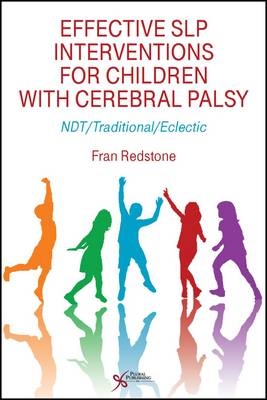
Effective SLP Interventions for Children with Cerebral Palsy
Plural Publishing Inc (Verlag)
978-1-59756-473-1 (ISBN)
Fran Redstone, PhD, CCC-SP, C/NDT, is an associate professor at Adelphi University in New York.
Preface Acknowledgments Contributors Chapter 1. Introduction: The Development in Neurodevelopmental Treatment (NDT) for the SLP - Fran Redstone How a child's motor milestones relate to achievement of functional oral - motor and cognitive/linguistic skills. Chapter 2. The ABCs of NDT - Fran Redstone What is cerebral palsy? What is neurodevelopmental treatment? Why is this important for the SLP? Chapter 3. ABCs of CP and Accompanying Motor Speech Disorders: An Overview - Marilyn S. Workinger The underlying neurology and causes of the categories of cerebral palsy is presented along with associated disorders. The characteristics of each category, why they developed, and how they affect functioning of children with cerebral palsy. Assessment principles, including classification of function, are presented with implications for intervention. Chapter 4. Feeding the Whole Child Using NDT - Fran Redstone An NDT approach for assessment and intervention for feeding disorders in the child with cerebral palsy is presented. A dual-track method that addresses both feeding therapy and eating during daily routines is offered. This intervention includes positioning along with techniques for both sensory and oral - motor challenges. Chapter 5. Feeding in the NICU - Marjorie Palmer Most children with cerebral palsy are premature and begin life in the NICU. The first SLP to see this child/family will necessarily deal with feeding issues. Chapter 6. Respiratory Control - Fran Redstone Respiration for tidal, speech, and feeding functions are discussed. The development of the coordination between breathing and swallowing is stressed. Evaluation and treatment using NDT principles are presented. Chapter 7. NDT and Speech Sound Production - Leslie Faye Davis and Fran Redstone Development of the coordination of systems for respiratory/phonatory output of the child with cerebral palsy is presented. Intervention including handling, NDT speech sound production, and other motokinesthetic approaches are discussed. Chapter 8. Saliva Control and Drooling in Children with Cerebral Palsy - Fran Redstone Drooling is a common problem that originates from the primary motor impairment and impacts social interactions as the child matures. Chapter 9. Early language Intervention and Interaction - Fran Redstone Prior to the need for an AAC device, a child with cerebral palsy can develop early communication and language skills including reciprocity, negation, affirmation, and choice-making. Methods to assess and facilitate these early skills are presented. Chapter 10. AAC for Children with Cerebral Palsy - Cindy Geise Arroyo Cerebral palsy presents challenges for the development of communication skills. Early development of language through assisted technology is presented along with the motor considerations needed to be addressed by the SLP. Chapter 11. Literacy Challenges and Early Intervention for Children Using Aided Communication: Starting Well - Martine M. Smith Although children with cerebral palsy may need literacy skills to efficiently use an AAC device, few learn the preliteracy skills necessary at the age-appropriate time. This chapter presents the principles that an SLP needs to address when working with young children with cerebral palsy. Additionally, it encourages the SLPs to do this routinely as they would for other children with early communication disorders. Chapter 12. Commentary on Evidence-Based Practice and NDT - Fran Redstone This chapter presents evidence that NDT is supported by a theoretical base as well as individual studies that demonstrate as much evidence for its use as other approaches and techniques for children with cerebral palsy. Indications of bias in funding, publication, and interpretation are discussed along with the problems of providing high levels of evidence for this heterogeneous group of children. Other important issues are presented that include the differences between providing services in a clinical setting versus a research study and the importance of the clinical relationship in determining positive outcomes. Index
| Verlagsort | San Diego |
|---|---|
| Sprache | englisch |
| Maße | 152 x 229 mm |
| Gewicht | 544 g |
| Themenwelt | Medizin / Pharmazie ► Gesundheitsfachberufe ► Logopädie |
| Medizin / Pharmazie ► Medizinische Fachgebiete ► Pädiatrie | |
| ISBN-10 | 1-59756-473-7 / 1597564737 |
| ISBN-13 | 978-1-59756-473-1 / 9781597564731 |
| Zustand | Neuware |
| Haben Sie eine Frage zum Produkt? |
aus dem Bereich


